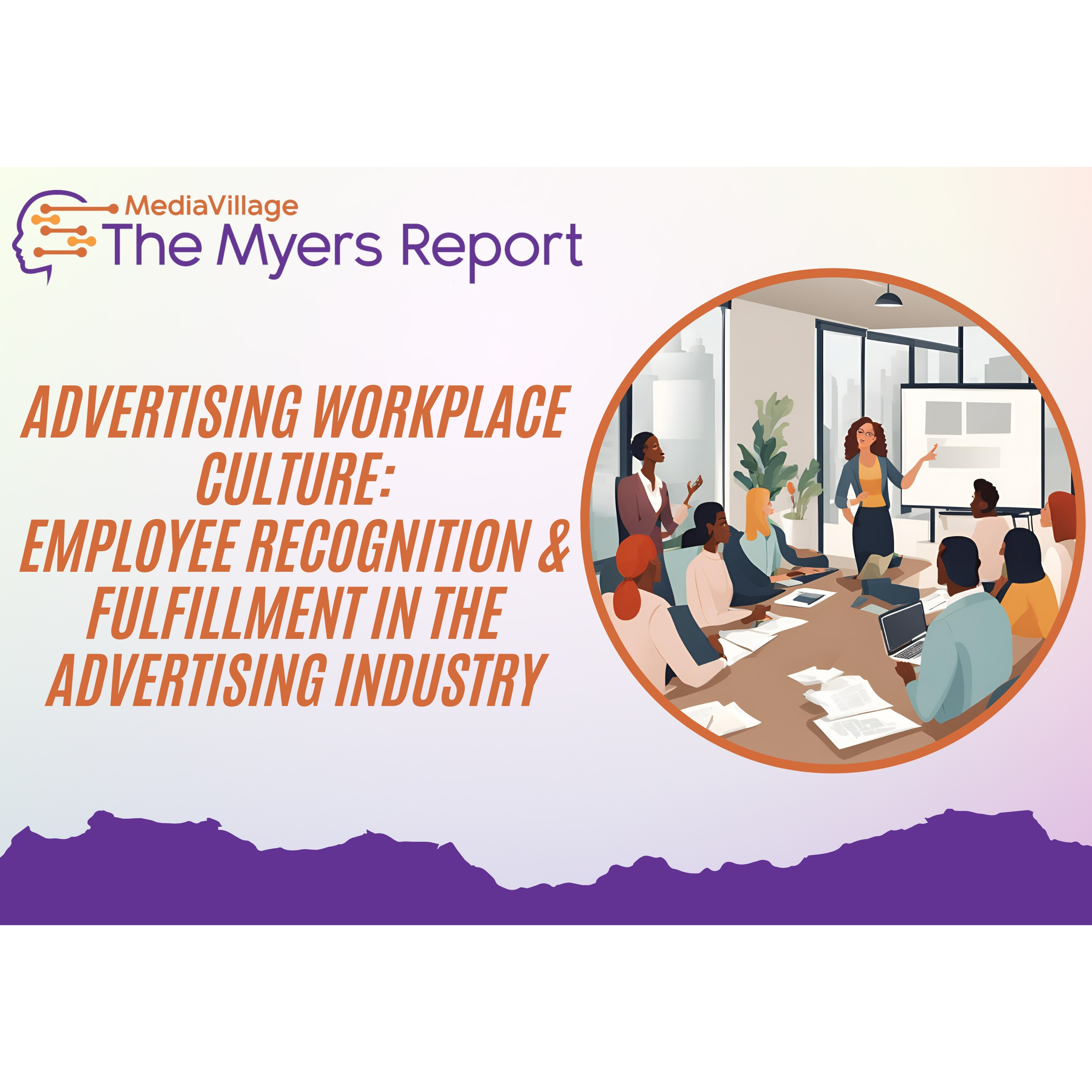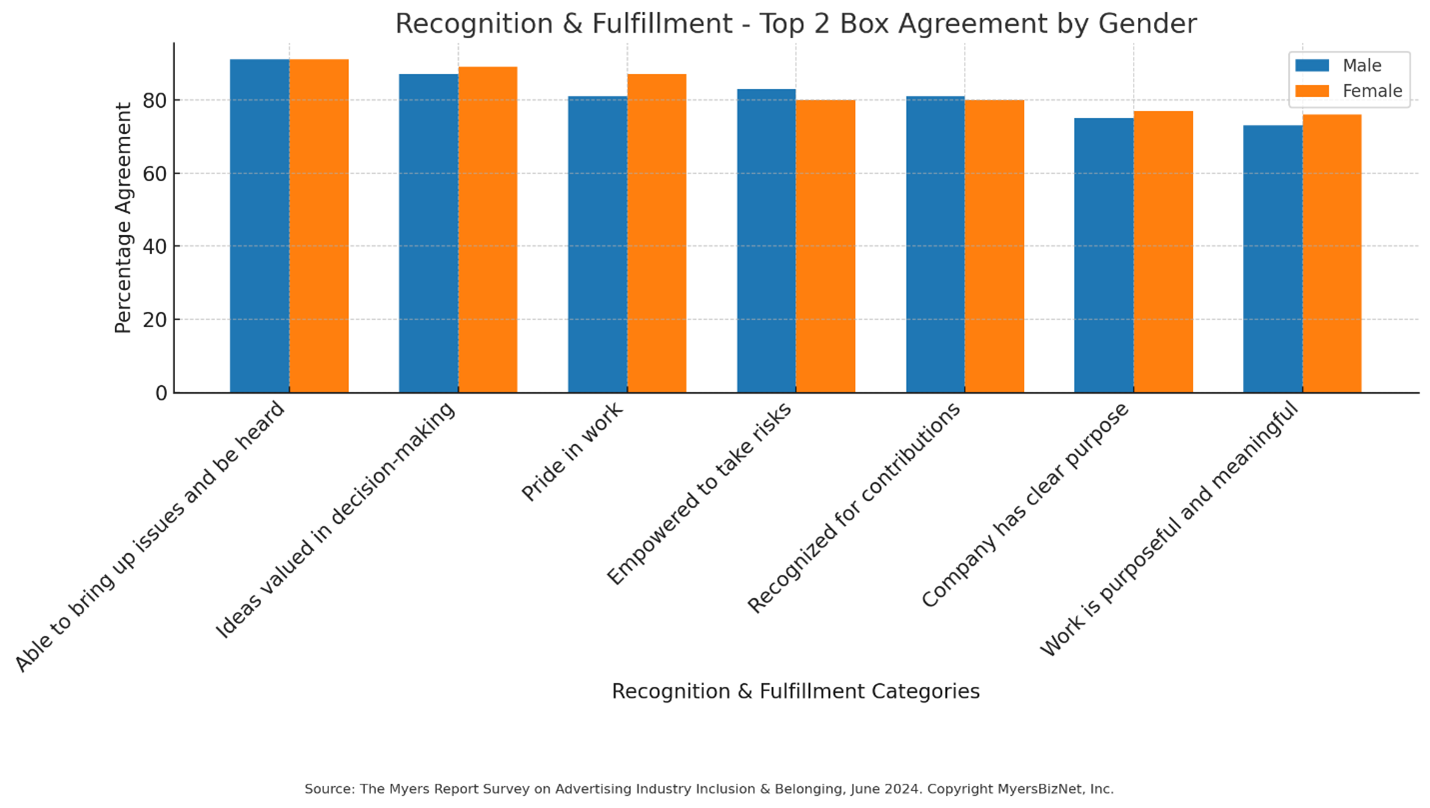The Myers Report on Advertising Workplace Culture: Employee Recognition & Fulfillment in the Advertising Industry

The 2024 Survey of Advertising Professionals on Inclusion and Belonging by The Myers Report offers a comprehensive analysis of workplace culture within the advertising industry. This particular section of the survey focuses on employee recognition and satisfaction, providing insights into how various demographic cohorts perceive their work environment. The results are critical for leaders in the advertising profession who aim to foster a positive and inclusive workplace culture that enhances employee satisfaction, retention, and recruitment. The June 2024 survey included 3,462 advertising professionals and was funded by leading media companies. Survey questionnaires were distributed through partners like Publicis Media, GroupM, dentsu Americas, Canvas Worldwide, Association of National Advertisers, American Association of Advertising Agencies, and Media Financial Management Association.
Key Findings
Overall Satisfaction and Recognition
- High Satisfaction Categories:
- Ability to Raise Concerns: The highest level of satisfaction (90% agreement) was recorded in the category where employees felt they could bring up problems and tough issues to their superiors and be heard.
- Valued Ideas and Suggestions: A strong majority (88% agreement) felt that their ideas and suggestions were valued in decision-making processes.
- Lowest Satisfaction Categories:
- Purposeful and Meaningful Work: The category with the lowest overall satisfaction was "I feel that my work is purposeful and meaningful," with only 74% of respondents agreeing. This indicates that a significant portion of employees may feel disconnected from the larger mission of their organizations.
- Recognition and Appreciation: Only 80% of respondents felt recognized and appreciated for their contributions, which, while generally positive, suggests a potential area for improvement in how companies acknowledge individual achievements.
Demographic-Specific Insights
- Gender Differences:
- Pride in Work: There was a slight gender difference in the feeling of pride when sharing their work with friends and family, with 81% of men agreeing versus 87% of women.
- Purposeful Work: Men also reported lower agreement (73%) in feeling that their work is purposeful and meaningful compared to women (76%).
- Age Group Variations:
- Older Professionals (55+): This cohort reported the highest levels of satisfaction across several categories, including feeling heard by superiors (93%) and pride in their work (92%).
- Younger Professionals (18-34): The younger cohort showed lower satisfaction levels in the category of feeling that their work is purposeful and meaningful (71%), suggesting a potential disconnect for a meaningful group between their roles and the organization's mission.
- Ethnic and Identity Group Differences:
- Caucasian Employees: This group reported higher satisfaction in multiple areas, including feeling heard (92%) and empowered to take risks (83%).
- Black/African American and Hispanic/Latino Employees: While these groups also reported high levels of satisfaction in many areas, there were notable disparities in feeling empowered to take risks, where Black/African American employees reported lower agreement (77%) compared to Caucasians (83%).
Chart: Recognition & Fulfillment - Top 2 Box Agreement by Gender
Recognition & Fulfillment - Top 2 Box Agreement by Gender

This chart highlights the gender differences in satisfaction across various categories of recognition and fulfillment in the workplace. The chart reveals that while overall satisfaction is relatively high, women generally report higher levels of satisfaction across most categories, particularly in feeling pride in their work and believing that their work is purposeful and meaningful.
Analysis of Key Differences and Similarities Among Demographic Cohorts
- Gender Differences:
- Higher Female Satisfaction: Women reported higher satisfaction in categories such as feeling pride in their work (87%) and believing their work is purposeful and meaningful (76%) compared to men (81% and 73%, respectively). This suggests that women may feel a stronger connection to the mission of their organizations and the impact of their work.
- Empowerment to Take Risks: Men were slightly more likely to feel empowered to take risks (83%) compared to women (80%). This could indicate a potential area where gender biases might influence perceptions of risk-taking in the workplace.
- Age Group Differences:
- Older Professionals (55+): This group consistently reported higher levels of satisfaction across most categories, particularly in feeling heard (93%) and pride in their work (92%). This could reflect the experience and seniority that often come with age, leading to greater confidence in raising issues and a deeper connection to their work.
- Younger Professionals (18-34): This cohort reported the lowest satisfaction in feeling that their work is purposeful and meaningful (71%), suggesting a potential disconnect between their daily tasks and the larger organizational mission.
- Ethnic and Identity Group Differences:
- Caucasian Professionals: Caucasians reported higher satisfaction in being heard (92%) and empowered to take risks (83%) compared to other groups. This suggests that Caucasians may feel more confident and supported in their work environment, possibly due to fewer systemic barriers.
- Black/African American and Hispanic/Latino Professionals: While generally satisfied, these groups reported lower satisfaction in feeling empowered to take risks (77%) and in feeling that their work is purposeful (80% for Black/African American and 79% for Hispanic/Latino). These disparities indicate that these groups may experience more challenges in feeling fully supported and recognized in their roles.
Areas for Improvement and Amplification
- Addressing Disparities in Empowerment:
- Focus on Empowering Minorities: Leaders should focus on initiatives that empower Black/African American, Hispanic/Latino, and other underrepresented groups to take risks and feel supported in decision-making processes. This could include mentorship programs, leadership development, and inclusive decision-making practices.
- Enhancing Purposeful Work for Younger Professionals:
- Aligning Work with Mission: Organizations should explore ways to better align the daily tasks of younger professionals with the overall mission of the company. This might include clearer communication about how individual contributions impact the company's goals or providing opportunities for younger employees to engage in mission-driven projects.
- Amplifying Positive Outcomes:
- Leverage High Satisfaction for Recruitment: The high levels of satisfaction among older professionals and the generally strong sense of recognition among women should be amplified in recruitment and retention efforts. Highlighting these positive aspects can attract talent who value a supportive and inclusive work environment.
- Recognizing Contributions and Valuing Ideas:
- Broaden Recognition Programs: To address the lower satisfaction in the area of recognition, companies should broaden their recognition programs to ensure that contributions from all levels and demographics are acknowledged. This can include peer recognition initiatives, transparent promotion criteria, and public acknowledgment of achievements.
Contextual Insights from Broader Market Data
Compared to other corporate sectors, the advertising industry shows unique patterns in workplace culture:
- Creativity and Risk-Taking: The advertising profession places a strong emphasis on creativity and risk-taking. However, the slightly lower levels of perceived empowerment to take risks among minority groups suggest that more work needs to be done to create a fully inclusive environment where everyone feels equally able to contribute bold ideas.
- Purpose-Driven Work: National U.S. data from studies like Gallup's State of the American Workplace often highlight that employees who find their work purposeful are more engaged and productive. The lower satisfaction in purposeful work among younger professionals in advertising could be reflective of the high-paced, client-driven nature of the industry, where long-term mission alignment can sometimes be overshadowed by short-term project goals.
- Recognition and Fulfillment: While the advertising industry often celebrates creativity, the slightly lower scores in recognition and appreciation compared to other sectors suggest that more formalized recognition systems might be needed to ensure that all employees feel valued.
DISCLAIMER: The results presented in this report are based on a survey conducted by The Myers Report in June 2024, involving 3,462 advertising professionals. While the respondent base is representative of the media advertising community, it is important to note that the results are influenced by the characteristics of those who volunteered to respond to the survey request. Participation was incentivized with offerings such as contributions to continuing education or college loan relief, an Oculus Quest, and $50 gift certificates. The survey responses are subject to self-selection bias, meaning those who chose to participate may differ in significant ways from those who did not. As a result, the findings may not fully represent the views and experiences of the entire industry. The incentives offered for participation may have influenced the respondent pool, attracting individuals who were motivated by these rewards. While efforts were made to ensure a diverse and representative sample, caution should be exercised when generalizing these results to the broader population of media advertising professionals. The data collected is based on self-reported information, which can be subject to inaccuracies or biases inherent in self-reporting. The Myers Report aims to provide valuable insights into the media advertising community through regular reports. However, readers should consider these limitations when interpreting the findings and making decisions based on this report.

